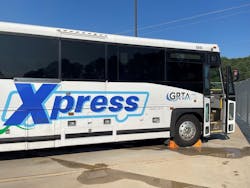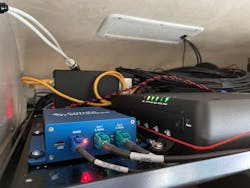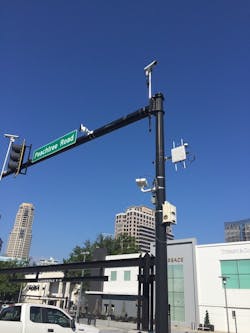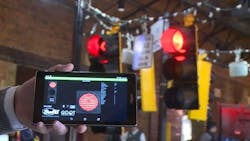Signal priority in Georgia and V2X as a solution
For over a decade, the Georgia Department of Transportation (GDOT) has prioritized resources and partnered with local governments to support the active management of traffic signal systems throughout the state.
This regional cooperation has enabled GDOT to proactively manage and maintain traffic signals statewide by leveraging both existing and emerging technologies.
One major area of investment has been Vehicle-to-Everything (V2X) infrastructure and applications. In 2015, GDOT modernized its statewide traffic signal framework by upgrading software in over 8,000 traffic signals. This system is the backbone of our traffic signals and enables both V2X applications as well as advanced operational strategies like transit signal priority (TSP).
Before this upgrade, GDOT typically did not implement operational strategies like TSP, leaving its execution up to local governments. However, advancements and investments in regional resources, deployments, and partnerships, allowed for GDOT to be more engaged in priority applications.
Piloting V2X for TSP
Beginning in 2017, GDOT began outfitting traffic signals with roadside infrastructure enabling communication with vehicles over the 5.9 GHz band dedicated to transportation safety, commonly known as the 5.9 GHz Safety Band. Primarily focusing on traffic signal-based applications, GDOT in 2018 scaled this technology deployment to a planned 1,600 signals. A partnership with the Atlanta Regional Commission (ARC) expanded V2X infrastructure across the metro Atlanta region to an additional 1,000 intersections. The Atlanta region is rapidly becoming equipped with a baseline of connectivity that GDOT envisioned, delivering advanced safety and mobility applications for a growing fleet of connected vehicles. Through these projects, over 2,600 intersections will be equipped with roadside infrastructure operating on the 5.9 GHz band.
As part of this growing ecosystem, GDOT partnered with the State Road and Toll Authority (SRTA) to pilot TSP using V2X on one of the agency’s Xpress bus routes where schedule reliability was an issue. The goal was simple: use transit signal priority to improve the schedule reliability of transit vehicles along a signalized corridor. Modeled after similar deployments by the Utah Department of Transportation, GDOT granted conditional priority for buses running more than five minutes behind schedule. Buses meeting this condition would transmit a priority request message from their onboard units to roadside units at the traffic signal using Dedicated Short-Range Communications (DSRC). The amount of priority the signal system could provide would be pre-designed based on balancing traffic demands throughout the Midtown Atlanta signal system.
Deployment and implementation of this system was a powerful combination of several resources and partners: in addition to SRTA, GDOT worked with their connected vehicle deployment team of Atkins and Southwest Research Institute to deploy, configure, test, and validate the connected vehicle infrastructure both at the roadside and on vehicles. Kimley Horn and Associates provided signal timing expertise through GDOT’s Regional Traffic Operations Program, intricately designing the signal timing parameters that empowered how much extra green time could be given at any location for the project's traffic signals.
Results and Lessons Learned
The initial implementation of the deployment was delayed for almost a year due to the COVID-19 pandemic. Fine tuning and testing of the system’s positioning elements required significant field work which was not possible due to social distancing and safety concerns. However, the team found innovative ways to demonstrate and deliver on the project despite public health and safety challenges.
Prior to enabling the V2X devices, the signal operations team conducted field demonstrations of the TSP system. A team member drove through intersections while on a cell phone video call while another remotely triggered priority calls through a web interface at intersections in order to simulate the bus’s route. This allowed for a realistic demonstration and data gathering experiment to fine-tune the signal system. Each intersection and pattern were evaluated by the signal timing team to best determine how much additional green time could be given to an intersection movement while maintaining core functionality and safety obligations, such as system progression and pedestrian timings. While many congested intersections allowed no additional time, some intersections allowed up to 20 additional seconds to a phase movement per cycle. The end result was a signal timing strategy that provided priority to transit vehicles while balancing the demands of vehicular and pedestrian modes on the corridor.
The challenges of Midtown Atlanta for the connected vehicle team were substantial. Tall buildings interfered with accurate GPS positioning for onboard equipment, inhibiting buses from requesting priority at some intersections. In order to compensate for the positioning issues, the team made algorithm adjustments within the bus onboard units. These changes allowed the system to appropriately determine the bus’s approach and request priority at the correct time. MAP messages also had to be updated to offset the many infrastructure and construction projects in Midtown Atlanta.
In addition to these challenges, deployment occurred while the Federal Communications Commission (FCC) issued proposed changes to spectrum allocation, which created the need to adjust implementations to comply with coming orders from the commission.
Data Fusion and Evaluation
As part of the pilot period for this project, system performance is evaluated by leveraging several different data. Basic Safety Messages (BSMs) are logged on the buses to determine their position and headings, as well as speed. Buses are programmed to only request priority when they are five or more minutes behind schedule, so evaluating that conditional priority is essential as an outcome of the pilot itself. Though the framework of V2X systems ensures anonymity within data, this deployment configured the buses with unique identifiers so that their performance could be tracked and monitored through the system.
The traffic signals are also logging all their events in high resolution, allowing for a robust fusion of information from both the vehicle and the infrastructure itself. The actual priority requests are logged to determine if, and when, priority was given, and intersection and corridor level metrics are evaluated through Automated Traffic Signal Performance Measures (ATSPMs) to determine operational impacts of the priority application.
The Future for Priority Applications in Georgia
Regional interoperability and open protocols for systems are key goals for GDOT’s technology deployments. Furthermore, the promulgation of V2X applications into vehicles furthers the vision set out for the 5.9 GHz band. Therefore, GDOT continues to see V2X as a primary means for accomplishing priority-based applications throughout the region. GDOT will continue to work with local agencies to identify and accomplish signal priority strategies where needed, all while balancing the needs of all modes within our transportation network.
Transit is not the end of the story for signal priority. This year, GDOT has been working with freight operators to implement freight signal priority. This additional pilot will provide the same operational benefit as transit vehicles to freight operators moving in and out of port facilities, improving the efficiency and safety in the movement of goods. Future applications could be expanded to prioritize freight movements that are operating in a cooperative manner, such as automated trucks moving in a connected platoon.
Implementing signal priority strategies through V2X continues to provide benefits to public sector fleets in Georgia and will expand to further safety benefits as more private vehicles are equipped with this life-saving technology.




